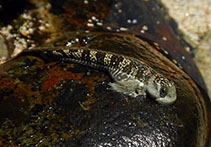| Family: |
Blenniidae (Combtooth blennies), subfamily: Salariinae |
| Max. size: |
10.5 cm TL (male/unsexed) |
| Environment: |
demersal; marine |
| Distribution: |
Western Pacific: Ryukyu Islands and Indonesia. |
| Diagnosis: |
Dorsal spines (total): 16-17; Dorsal soft rays (total): 17-18; Anal spines: 2-2; Anal soft rays: 24-25. Description: Dorsal fin XVI-XVII, 17-18, spines with filamentous tips, the 2nd dorsal spine elongated particularly in males; anal fin II, 23-24; pectoral rays 15; pelvic fin I,4; unbranched caudal rays; last anal ray bound to caudal fin by a membrane. Mouth with numerous movable jaw teeth; crenulated lips margin; lower lip with fleshy disc, cup-shaped. Both sexes with occipital crest; nuchal cirri absent; supraorbital cirrus pinnate; nasal cirrus small and simple (Ref. 559, 90102). Body elongate; depth at anal fin origin 7.5-8.5 in SL. Overall greyish brown, ventrally white; body with spotty vertical bars; head and base of pectoral fin with spots, brown and small (Ref. 90102). |
| Biology: |
Found on rocks in the surf line constantly washed by sprays or breakers. Attains less than 12 cm TL. Oviparous. Eggs are demersal and adhesive (Ref. 205), and are attached to the substrate via a filamentous, adhesive pad or pedestal (Ref. 94114). Larvae are planktonic, often found in shallow, coastal waters (Ref. 94114). |
| IUCN Red List Status: |
Data deficient (DD); Date assessed: 23 March 2009 Ref. (130435)
|
| Threat to humans: |
harmless |
Source and more info: www.fishbase.org. For personal, classroom, and other internal use only. Not for publication.

